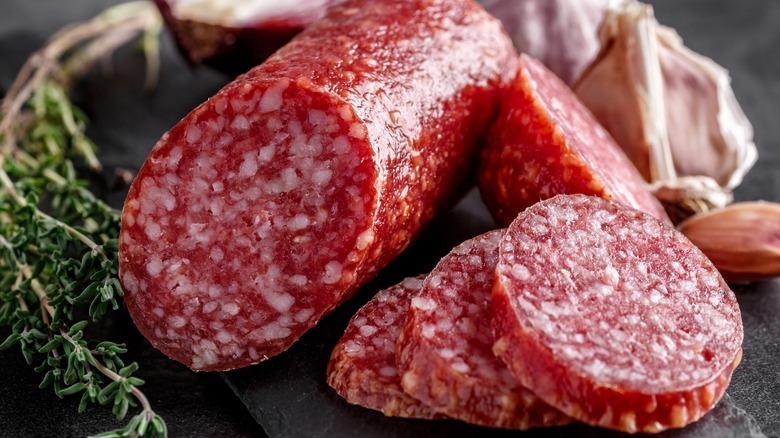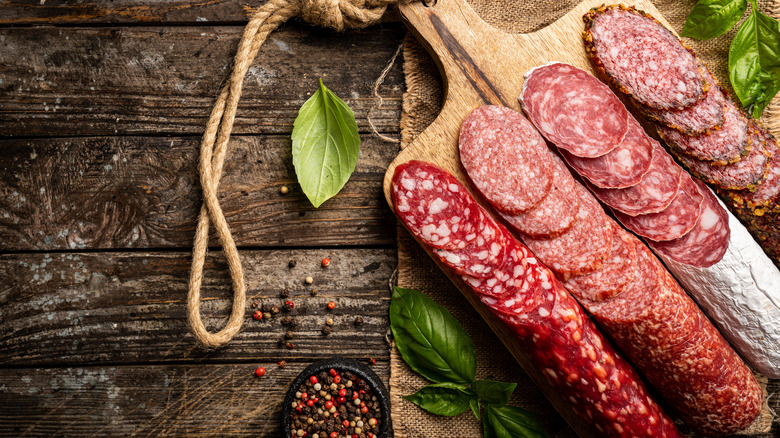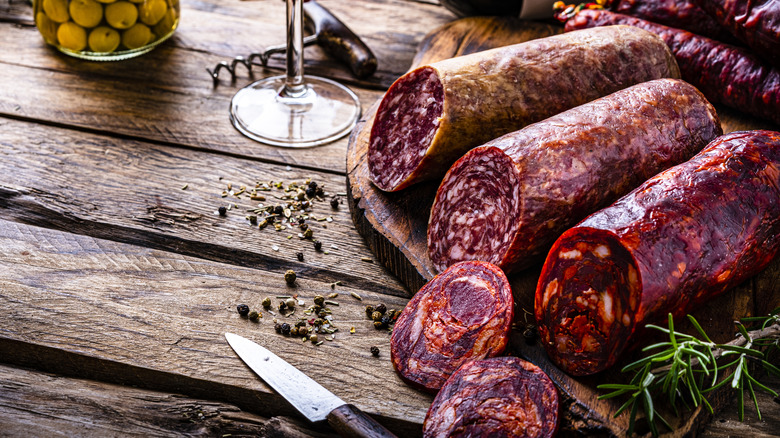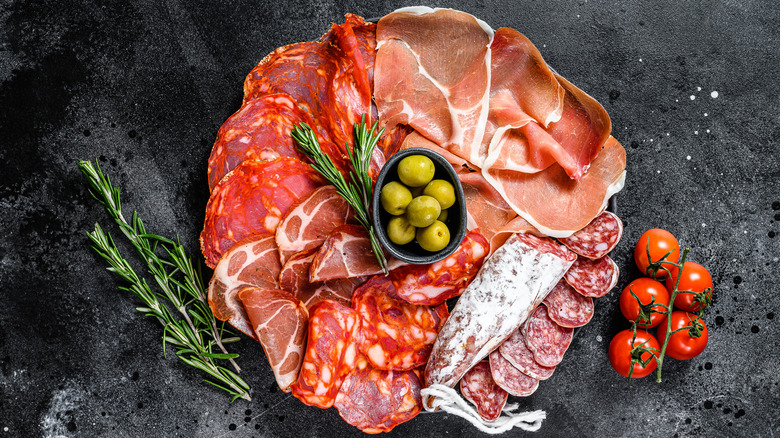What's The Difference Between Pepperoni And Salami?
Pepperoni and salami are both cured meats that many people are familiar with. While each offers distinct flavors and textures, you might not actually know what exactly sets them apart. Pepperoni, widely recognized for its peppery kick, is a type of salami with a characteristically bold taste thanks to a mix of paprika and chili pepper. It's typically air-dried and heavily seasoned, giving it its vibrant red hue and smoky personality. In contrast, salami encompasses a broader category of cured sausages with countless regional variations. Depending on the type, salami can be mild or bold and often includes spices like garlic and black pepper. Salami's texture can range from soft to firm, while pepperoni leans toward the soft side.
So, while they share the same curing process and basic ingredients, pepperoni and salami diverge in their distinct flavor profiles, textures, the meats they are made from, and how they are used, making each a unique and delectable addition to a number of dishes. Let's dive into the details of what defines salami and sets pepperoni apart as a specific type of salami.
What is salami?
Salami, a savory and flavorful cured meat, boasts a rich history that spans centuries and continents. Its origins can be traced back to ancient civilizations, including the Roman Empire, where preservation techniques were essential to survival. Salami was born out of the necessity to store and preserve meat, with its name derived from the Italian verb salare, meaning "to salt."
Salami is traditionally made by mixing ground meat (often pork, though beef, venison, and other meats are used) with salt, spices, and curing agents. The mixture is then stuffed into casings, where it undergoes a slow fermentation and aging process that can last for weeks or even years. This fermentation not only preserves the meat but also imparts the distinctive tangy and complex flavors that salami is known for. Throughout history, salami has evolved to include numerous regional variations, each with its own unique blend of spices and flavor profiles. Salami remains a beloved and versatile ingredient, lending its robust flavor to a wide array of dishes across the globe.
What is pepperoni?
Pepperoni, the spicy and iconic pizza topping, has a fascinating history that adds a zesty twist to its origins. While it may seem quintessentially Italian, pepperoni as we know it today is more of an American creation. Its roots can be traced back to Southern Italy, where a variety of cured sausages seasoned with pepper existed. However, the term "pepperoni" itself didn't take on its pizza identity until it crossed the Atlantic.
In the United States, particularly in cities like New York, Italian immigrants adapted their culinary traditions to suit American tastes. They transformed the traditional sausage into a spicier and tangier version seasoned with paprika and chili pepper flakes to create what we now know as pepperoni. This Americanization of Italian sausage led to its widespread popularity, eventually earning it a spot as a must-have pizza topping. Today, pepperoni is a beloved staple of pizzerias and delis across the United States and beyond, prized for its bold, spicy flavor and appealing texture when cooked on a pizza. Its journey from Italy to America showcases the dynamic nature of culinary traditions and the way they adapt and evolve in response to changing tastes and cultural influences.
Pepperoni is made of beef and pork
One of the primary distinctions between pepperoni and salami lies in the meats used to craft these flavorful cured delights. Pepperoni is typically made from a blend of beef and pork, with a higher proportion of beef in most recipes. This combination imparts a robust and slightly spicy flavor to pepperoni, thanks in part to the addition of paprika and chili pepper flakes. The meat is finely ground and mixed with a blend of spices and seasonings, creating the signature zesty taste that pizza lovers adore.
In contrast, salami embraces a broader range of possibilities when it comes to meat selection. While pork is often the primary meat used, salami recipes can incorporate a variety of meats, including beef, veal, or even game meats like venison. This diverse meat selection lends salami its unique and complex flavor profiles, with different types of salami boasting distinct tastes and textures. The variation in meats also contributes to the varied appearance of salami, as each type may feature different marbling and colors, creating a mosaic of patterns when sliced.
So, while both pepperoni and salami are delicious examples of cured sausages, the meats used in their production give them their own distinct characteristics. Whether you prefer the fiery kick of pepperoni or the complex flavors of salami, both offer a delicious addition to your dishes.
Salami has a more nuanced flavor
With its rich culinary heritage and diverse regional variations, salami offers a more nuanced flavor palate when compared to the dependable simplicity of pepperoni. While both are cured sausages, salami takes its flavor game to another level by incorporating an array of aromatic spices and seasonings that vary from one type to another. These spices might include garlic, black pepper, fennel seeds, wine, and more. The combination of these carefully chosen spices, along with the diverse selection of meats used, gives salami its distinct and complex taste profile.
In contrast, pepperoni, as a subset of salami, tends to stick to a more straightforward spice blend. It leans heavily on paprika and chili pepper flakes to provide the characteristic flavor you expect. This simpler spice profile, while undeniably delicious, doesn't venture into the intricate interplay of flavors that other types of salami offer. Whether you savor the peppery kick of pepperoni or appreciate the nuanced symphony of flavors in salami, both have earned their rightful places. However, the meats and spices that make up each do not just differentiate the two types of salami by flavor profile. These characteristics also impact the texture.
Pepperoni has a homogenous texture
When it comes to textures, pepperoni and salami each bring their unique character to the table. Pepperoni, with its uniform and smooth texture, offers a consistent bite in every slice. Its finely ground meat coupled with the emulsification process used during production creates a homogenous texture that's also soft on the palate. This uniformity allows for a predictable, yet enjoyable, mouthfeel with each savory bite.
On the other hand, the texture of salami is where it truly shines, and it's a realm of delightful variation. Salami can differ widely in texture depending on the type and regional style. Some salamis boast a finely ground and firm consistency, while others exhibit a coarser, chunkier texture with visible pieces of fat, spices, and even whole peppercorns. This diversity in textures allows salami to cater to a wide range of preferences, from those who enjoy a smoother, more uniform experience to those who relish the complexity of a chunkier, more artisanal salami. In essence, while pepperoni tends to offer a consistent and smooth texture, salami proudly showcases its versatility by delivering a diverse array of textural experiences.
Salami can be used in a variety of ways
While both are beloved cured sausages, salami and pepperoni shine in distinct culinary roles. With its vast array of regional varieties, salami lends itself to a multitude of culinary applications. It can be the star of a charcuterie board, providing a diverse and flavorful selection for pairing with cheeses and wines. Salami also finds its way into pasta dishes, omelets, and salads, where its complex flavors and varying textures enhance the overall experience. Furthermore, it's a versatile ingredient for adding depth and zest to sandwiches, antipasto platters, and even gourmet pizzas.
Pepperoni, on the other hand, is a focused player in the culinary arena, often taking center stage as a pizza topping. Its bold flavor adds a delightful kick to the classic pie, making it a favorite choice among pizza enthusiasts. While it can make appearances in sandwiches and salads, pepperoni's primary role remains as the quintessential pizza topping, beloved for its ability to transform an ordinary slice into a deliciously smoky delight. So, whether you're savoring the versatility of salami or munching on a pepperoni slice, these cured sausages undoubtedly bring their unique flavors to the table.






